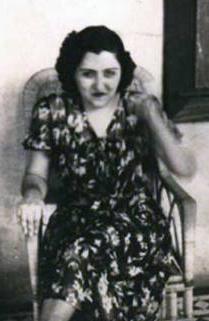| Esmat Dowlatshahi | |
|---|---|
 | |
| Born | Esmat ol-Molouk Dowlatshahi 1905 (1905) Kermanshah, Sublime State of Iran |
| Died | 25 July 1995(1995-07-25) (aged 89–90) Tehran, Iran |
| Burial | Behesht-e Zahra, Tehran |
| Spouse |
Reza Shah
(m. 1923; died 1944) |
| Issue | |
| House |
|
| Father | Prince Gholam Ali Mirza Dowlatshahi |
| Mother | Mobtahej Od-dowlah Morad |
Esmat ol-Molouk Dowlatshahi (Persian: عصمتالملوک دولتشاهی; 1905 – 25 July 1995) was an Iranian royal and the fourth and last wife of Reza Shah.
Early life
Dowlatshahi was born in 1905. She was a member of the Qajar dynasty. Her father was Gholam Ali Mirza "Mojalal Dowleh" Dowlatshahi (1878–1934). Her mother was Mobtahedj-od-Dowleh, daughter of Ebtehadj Saltaneh and Abou Nasr Mirza Hessam Saltaneh II. Her paternal grandfather was Hessam-Saltaneh I. She had two brothers and one sister, Ashraf Saltaneh II. Mehrangiz Dowlatshahi, member of the Majlis and Iranian ambassador, was her cousin.
Marriage

Dowlatshahi and Reza Shah wed in 1923. She was his fourth, last and favourite wife. Reza Shah was the minister of war when they married. From this marriage five children were born: Abdul Reza, Ahmad Reza, Mahmoud Reza, Fatemeh and Hamid Reza Pahlavi. Her husband became Shah of Iran in 1925. However, it was her husband's second wife Tadj ol-Molouk who was given a public role as queen. This situation did not make Tadj ol-Molouk happy due to her jealousy of Dowlatshahi which she disclosed in her memoirs.
Dowlatshahi and Reza Shah lived in the Marble Palace in Tehran with their children. She accompanied her husband to Mauritius when he was exiled there in September 1941, but she returned to Iran after a few months.
Later life and death

Dowlatshahi stayed in Iran after the 1979 Islamic Revolution. She visited the Museum of Reza Shah Pahlavi in Johannesburg, South Africa, on 16 June 1980. She died on 25 July 1995. She was buried in the Behesht-e Zahra cemetery, Tehran.
References
- ^ Anne Commire; Deborah Klezmer, eds. (2007). "Esmat (d. 1995)". Dictionary of Women Worldwide: 25,000 Women Through the Ages. Waterford, CT: Yorkin Publications. pp. 613–614. ISBN 978-0-7876-9394-7.
- Eileen Pollack (Fall 2004). "The Jewish Shah". Fourth Genre: Explorations in Nonfiction. 6 (2): 53. doi:10.1353/fge.2004.0041. S2CID 109585481.
- ^ Camron Michael Amin (2002). The Making of the Modern Iranian Woman: Gender, State Policy, and Popular Culture, 1865-1946. Gainesville, FL: University Press of Florida. p. 115. ISBN 978-0-8130-3126-2.
- Cyrus Ghani (2001). Iran and the Rise of the Reza Shah: From Qajar Collapse to Pahlavi Power. London: I.B.Tauris. p. 425. ISBN 978-1-86064-629-4.
- ^ Diana Childress (2011). Equal Rights Is Our Minimum Demand: The Women's Rights Movement in Iran 2005. Minneapolis, MN: Twenty-First Century Books. p. 40. ISBN 978-0-7613-7273-8.
- "Iranian Princess Fatemeh Pahlavi". The Beaver County Times. London. 2 June 1987. Retrieved 24 November 2013.
- ^ Janet Afary (2009). Sexual Politics in Modern Iran. Cambridge: Cambridge University Press. p. 194. ISBN 978-1-107-39435-3.
- ^ Mehdi Jangravi. "Reza Shah's Wives". Institute for Iranian Studies. Retrieved 19 July 2013.
- "South Africa Museum". Associated Press. 16 June 1980. Retrieved 23 February 2022.
- "Reza Shah Pahlavi". Iran Chamber Society. Retrieved 19 July 2013.
- "Behesht-e Zahra Cemetery". Harmsen. Archived from the original on 2 October 2013. Retrieved 1 August 2013.
External links
 Media related to Esmat Dowlatshahi at Wikimedia Commons
Media related to Esmat Dowlatshahi at Wikimedia Commons